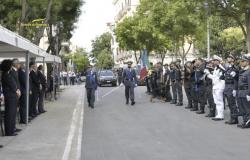3′ reading
06/17/2024 – After the ‘Bagni di Sole’ installation on one of the facades of Villa Marina – a symbolic place of the city – and the beginning of the process of rediscovering this “uncomfortable heritage” that links Pesaro to the history of colonialism and of global racism, from 17 June to 12 August the project continues with a series of urban billboards entitled ‘7 Internazionali’ placed in as many streets: Simoncelli, Albertini, del Lavoro on the roundabout side, Paganini, Togliatti, Velino.
Through images and wordsTommaso Fiscaletti and Nicola Perugini generate a new possible reading of the signs left by the abandonment of the imposing building. In this amalgam that crosses the fabric of the city on large billboards, the deterioration of the Villa Marina colony becomes – instead of a melancholic and nostalgic element of the “colony that once was” – a force that generates the disintegration of the idea of colonialism. Undo. Interfering in memory by connecting “things that have never yet been put together and that don’t seem willing to be.”
The curator underlines Tommaso Fiscaletti: this second act of ‘La Pelle Sotto’ represents in some way a summary of the dialogue between me and Nicola, the fusion of the tools that each of us uses in our work, our attempt to bring out memories and meanings that see Villa Marina as part of a current and urgent topic. The selected photographs are taken from a larger series that I have created over the last three and a half years, which we disseminate here in the urban context. It is important for us that the project is developing using public installations, for the city and its inhabitants: in this case by entering the space of the advertising posters we mix with the more immediate messages that they bring, creating an interference in the daily use of passers-by. This interference, in our creative process, has become the space in which images and words alter each other, creating friction between awareness and evocation. The architectural structure of the colony and the signs it carries with it are the emblem and create a sort of language to decipher, of which, in these posters, we imagine possible implications. I believe that it is imagination, precisely, that opens up new opportunities for reflection.
The other curator continues Nicola Perugini: with this new stage of the project we try to take a step forward after having reawakened the memory of the visitors and the city. After having rediscovered the link between the colony of Villa Marina, overseas colonialism and the global history of racial domination, the project seeks to work through the text and images of the colony’s ruin to ‘undo’ our colonial amnesia. There is no transformation of collective memory without the creation of interruptions, of glimpses that break the linearity of memory which for so many decades has removed the desire for fascist colonial domination and then found it again in the daily racial discrimination we witness in our country. Then the ruins of Villa Marina, which for so long we covered with fluttering sheets that made us scream at the sense of degradation that the ghost of the colony generated, acquires a productive force. Tommaso’s photographs generate links with the lion of the Libyan desert, Omar El Mokhtar; they generate the subversion of concepts dear to colonialism; they generate affection towards the oppressed of contemporary colonialism, towards Rafah, our twin city in the Gaza Strip. From the ruins of Villa Marina the flowers of the decolonization of memory are born.






